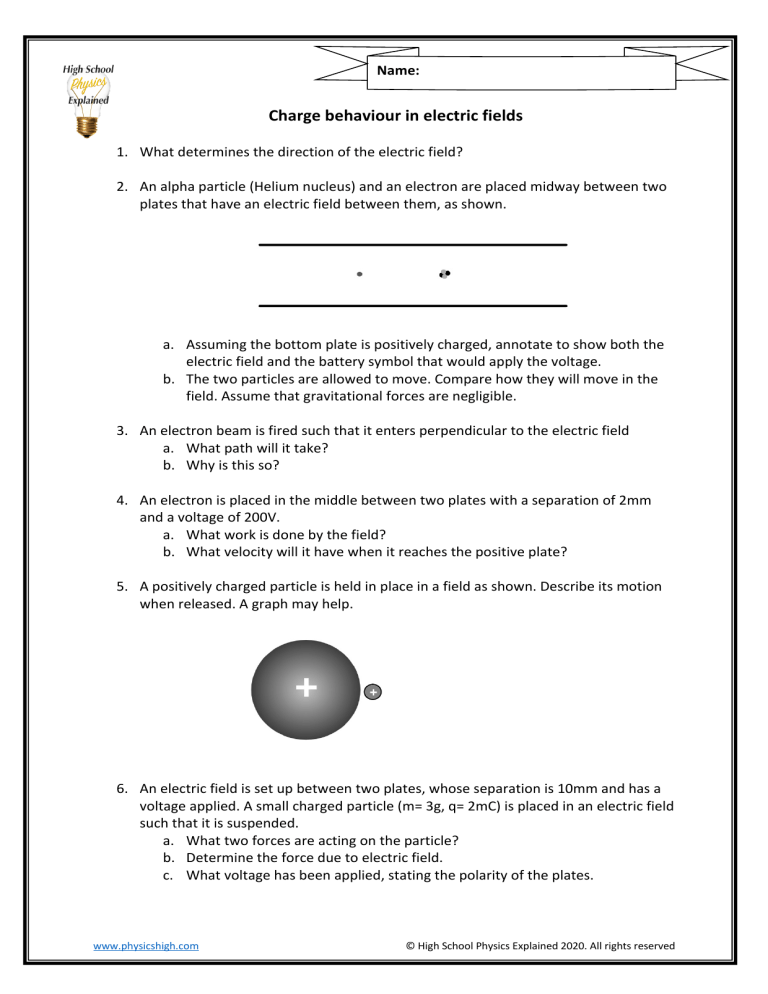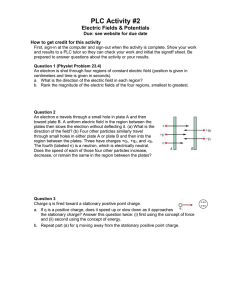
Name: Charge behaviour in electric fields 1. What determines the direction of the electric field? 2. An alpha particle (Helium nucleus) and an electron are placed midway between two plates that have an electric field between them, as shown. a. Assuming the bottom plate is positively charged, annotate to show both the electric field and the battery symbol that would apply the voltage. b. The two particles are allowed to move. Compare how they will move in the field. Assume that gravitational forces are negligible. 3. An electron beam is fired such that it enters perpendicular to the electric field a. What path will it take? b. Why is this so? 4. An electron is placed in the middle between two plates with a separation of 2mm and a voltage of 200V. a. What work is done by the field? b. What velocity will it have when it reaches the positive plate? 5. A positively charged particle is held in place in a field as shown. Describe its motion when released. A graph may help. 6. An electric field is set up between two plates, whose separation is 10mm and has a voltage applied. A small charged particle (m= 3g, q= 2mC) is placed in an electric field such that it is suspended. a. What two forces are acting on the particle? b. Determine the force due to electric field. c. What voltage has been applied, stating the polarity of the plates. www.physicshigh.com © High School Physics Explained 2020. All rights reserved 7. An electron is fired at 2 x 107 m/s between plates separated by 1.0 cm as shown What range will it have before it strikes the positive plate? 8. An electron is released from a cathode and accelerates towards a series of anodes that have a small hole, as shown. If the voltage between the two terminals is 200V, and the distance between being 1 cm, a. what is electric field strength? b. What is the work done on the charge? c. What will be the velocity as it passes through the first hole d. A simple linear particle accelerator has a series of anodes placed in the path of the moving charge. i. As the charge passes through the hole towards the next anode, the anode it just left needs to change polarity. Why is this needed? ii. This changing of polarity will have a certain frequency. Will this frequency be the same for all anodes or different? Explain why. 9. In 1909 Robert Millikan suspended charged oil droplets in an electric field, where the weight of the droplets was counterbalanced the force due to the electric field. By calculating their mass, and knowing the electric field strength, he was able to show that a range of oil droplets always carried a discrete multiples of a specific charge value. He was able to thereby determine the fundamental charge of an electron (this is a simplified description.) Determine the mass of the oil drop suspended if the charge on it is 3000 times greater than the fundamental charge. The applied voltage is 968 V and plate separation is 8mm www.physicshigh.com © High School Physics Explained 2020. All rights reserved Answers 1. Electric field lines represent the direction of the force on a positively charge particle in the field. As a result, work will be done on that charge in that field, but work has to BE done on an electron in that field. 2. a. b. Both charges will experience the same magnitude of force and therefore will accelerate. However, the electron will experience a force in the downward directions whereas the alpha particle, being positively charged, will experience an upward force. The alpha particle is also significantly heavier than the electron. Therefore the acceleration of the alpha particle will be significantly slower than that of the electron 3. a. it will be parabolic. b. The only force it experiences once in the field is a vertical force which is constant (assuming a uniform electric field). Hence its vertical acceleration will be constant. It is also traveling at a constant velocity horizontally which does not affect its vertical motion (independent) This is known as projectile motion and is governed by the quadratic formula s = ut + ½ at2. 4. a. W = qV = 1.6 x 10-19 x 100 = 1.6 x 10-17 J b. W = K; 1.6 x 10-17 = ½ mv2 v2 = 2 x (1.6 x 10-17)/9.1 x 10-31 = 3.52 x 1013 v = 5.93 x 106 m/s 5. It will accelerate away from the main dome. However, due to the weakening electric field, its acceleration will decrease at a constant rate 6. a. gravity and force due to charge b. since net F = 0, FE = Fg = mg = 3 x 10-3 x 9.8 = 0.0294 N c. E = F/q = 0.0294 / 2 x 10-3 = 14.7 NC-1 V = Ed = 14.7 x 0.01 = 0.147 V. Since the charge is positive, the upper plate must be negative www.physicshigh.com © High School Physics Explained 2020. All rights reserved 7. E = V/d = 100V/0.01m = 1 x 104 Vm-1 F = Eq = 1 x 104 Vm-1 x 1.6 x 10-19 C = 1.6 x 10-15 N a = F/m = 1.6 x 10-15 N / 9.1 x 10-31 kg = 1.76 x 1015 m/s2 v= u = 0 m/s a = 1.76 x 1015 m/s2 s = 0.01m t=t s = ut + ½ at2 0.01 = ½ (1.76 x 1015)t2 t = 3.37 x 10-9 s vx = 2 x 107 m/s t = 3.37 x 10-9 s. s=? s = vt = (2 x 107)( 3.37 x 10-9) = 0.067m. (6.7 cm) 8. a. E = V/d = 2000V/0.01m = 200,000 V/m (or N/C)) b. W = Vq = 2000V x 1.6 x 10-19 C = 3.2 x 10-16 J c. W = K = ½ mv2 v2 = 2W/m = 2 x 3.2 x 10-16 J / 9.1 x 10-31 kg = 7.033 x 1014 v = 2.65 x 107 m/s d. i . As the charge passes through the first plate, it will be attracted by the second plate, but in order to continue to accelerate in an electric field, the previous plate ill need to be negative, otherwise no uniform electric field will exist between them ii. The frequency will have to increase. This is due to the fact that the electrons are continuing to speed up. Since the distance separating the anodes are the same, the electrons will traverse each gap more quickly than the previous. (The exact value is not simply due changes in velocity due to acceleration. As the speeds increase closer to relativistic speeds, mass dilatory effects / relativistic momentum, needs to be considered) 9. Eq = mg Vq/d = mg (since V=Ed). m = Vq/dg m = (968V)(3000 x 1.6 x 10-19 C))/(8 x 10-3 m x 9.8 m/s2) = 5.93 x 10-12 kg www.physicshigh.com © High School Physics Explained 2020. All rights reserved




